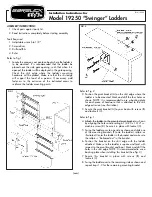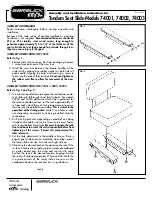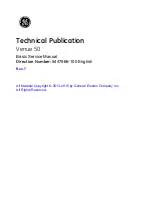
20
Switchblade for 3D multimedia and fast panning and 3D
motion of the audio signals are occurring. If the activity is
high enough and the Anti- Zippering feature is turned on the audio may appear to move in larger than normal steps from one
image position to another. If this is objectionable then execute this command and the motion will smooth up at the expense of
zipper artifacts which may or may not be objectionable depending on the audio source. . This command must be executed in
it’s own Sys-Ex file. The status of the Anti-zippering feature is displayed in the LCD when in remote mode.
07 ANTI-ZIPPERING ACTIVATE COMMAND: This command activates the Anti- zippering feature. This feature is
always activated whenever entering Remote mode from the Play (non remote) mode. This command must be executed in it’s
own Sys-Ex file. The status of the Anti- zippering feature is displayed in the LCD when in remote mode. It is recommended
that this feature remain activated except under the conditions described above as it is highly effective in removing zippering
and crackling noise created when using MIDI faders.
0D CONTROL OUTPUT ACTIVATE/DEACTIVATE COMMAND: This command is used to directly set the state of
each of the 2 control output relays in real time. This command must be executed in it’s own sys-ex file. 1 additional byte is
required. This byte has a binary format of 000000xx where the 2 lower bits of the byte indicate the state of the 2 relays. If the
bit is set the relay is closed and if the bit is cleared it is open. Bit 0 is controls relay 1, bit 1 controls relay 2. The upper 6 bits
are always set to 0.
An example of a data file is shown here. This file will clear the matrix then create a patch from input 1 to output 1 and assign
this connection to controller #0 then create a connection from input 2 to output 5 and assign it to controller #1.
Data
Description
F0
Sys-Ex command
00 01 18
3 byte ID
20
Unit identification number if Switchblade is set at MIDI channel 1
01
Function (clear the matrix)
02
Function (create a patch)
00
first of 3 required bytes for this function (Input number 1)
00
Output number 1
00
Controller number to be assigned to this patch
02
Function (create a second patch)
01
Input number 2
04
Output number 5
01
Controller number to be assigned to this 2nd patch
F7
EOX (End Of Exclusive)
To exit remote and go back to the play mode to preset #17, the file would look like this.
Data
Description
F0
Sys-Ex command
00 01 18
3 byte ID
20
Unit identification number if Switchblade is set at MIDI channel 1
04
Exit remote command
16
Preset number 17
F7
EOX (End of Exclusive)
Note that normally the Exit Remote command will be in a file all by itself since it cancels any patching operations that might
be listed and just goes back to normal preset operations.
USES FOR DIRECT CONTROL: The direct control feature has limitations as well as advantages over using the Switchblade
under preset control. The main advantage is the fact that up to 32 controllers can be assigned to allow individual control of the
levels and panning of each patch using graphic faders and panners. This is useful for automated mixdowns. In addition the
direct programming allows the Switchblade to be operated from a remote location when none of the loaded presets will do.
The disadvantages are that some of the features that are available under preset control are not available with remote control.
The Autosweep is disabled in remote mode. The "scaleable fader" feature of presets is also unavailable in remote since all
patches are controlled independently although some sequencers have their own scaleable fader features. You may do "group
fading" in remote however since each patch can be assigned to the same controller number.


































